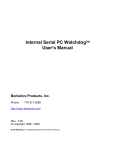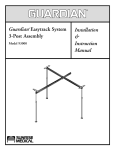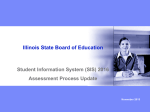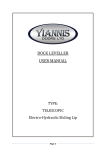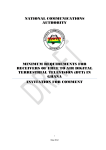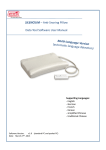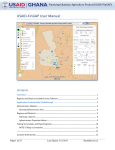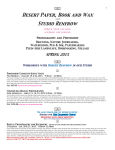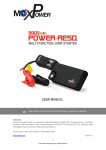Download "Wechiau Lighting Initiative - Interim Report," NCRC, July, 2007
Transcript
Wechiau Lighting Initiative Wechiau Community Hippo Sanctuary Upper West Region, Ghana, West Africa INTERIM REPORT JULY 2007 Donna J. Sheppard Sanctuary Advisor 25th July, 2007 1 Wechiau Lighting Initiative Wechiau Community Hippo Sanctuary, Upper West Region, Ghana, West Africa INTERIM REPORT: JULY 2007 Introduction The Wechiau Lighting Initiative (WLI) is into its third full year of fieldwork. As we continue to strive forward with our shared objective of providing solar lighting to residents of the Wechiau Community Hippo Sanctuary’s Development Zone, it is necessary to reflect on progress to date, developments during the first half of 2007, and primary issues. This interim brief reports on WLI activities for 2007 including: the shipment of further lighting stock to Ghana; the Light Up The World (LUTW) official site visit to the Wechiau Community Hippo Sanctuary (WCHS) in May; the installation of the Wechiau health clinic emergency gooseneck lamp; activities at Donna’s field laboratory; lighting maintenance, repair activities and systems development; and finally, progress with the social outcomes lighting survey. Furthermore, in the following pages, discussion is offered on critical issues pertaining to successful implementation of the WLI in the long term. Primary topics of discussion include: a solar lighting product review, an installation systems review; a review of lighting beneficiaries and their behavioural issues pertaining to use of solar systems; maintenance and trouble shooting issues; lighting stock and storage review; and a discussion about the social outcomes lighting survey. Suggested solutions or action steps have been outlined where available or relevant for each of these topics. Activity Update for 2007 Canadian Hydro Shipment of Lighting Stock A part shipment of remaining lighting stock to be used in the installation of systems within the hippo sanctuary was sent by Light Up The World on February 28th. The shipment was received in Ghana and transferred to NCRC Accra office for holding by the end of May. Included in the package were the following items: • 120 lamps • 60 panels • 285 electrical boxes • 400 diodes • 24 LED flashlights • Electrical cable, tape, silicon, screws, metal strapping and tools A further shipment will be delivered later in the year and is expected to complete the total product order of 550 lighting systems from Light Up The World. 2 Light Up The World Site Visit Light Up The World sent a team of two to inspect the development of solar lighting at Wechiau and to investigate additional potential solar lighting applications in other remote areas of the country. Over 10 days in May (May 17th to May 26th), Kim Veness and Grady Semmens explored NCRC-supported community conservation initiatives through rural Ghana. In addition to a visit at the Hippo Sanctuary, we held open meetings with established partners at the community based sitatunga project, manatee project, and up-and-coming leopard project. The team spent several days at the Hippo Sanctuary, visiting and filming families in their homes at night engaged in their various activities through the benefit of solar light. Light Up The World staff also met with local lighting staff, interviewing and filming some, and discussing solar lighting success with others. Local family members look on as the Light Up The World team member, Grady Semmens, films solar lighting systems in use Kim Veness examined lighting stock critically as it applies to northern Ghana field conditions. In particular, he recognized that the provided lamps are not ideal. They do not seal well and, as a result, smoke, grease, and insects enter into the lamps, creating an opaque film over the glass, thereby reducing light quality. During his Wechiau visit, Veness pledged to deliver replacement lamp stock to the entire WLI; the promise was welcome news to all involved in the solar lighting initiative. For their part, Wechiau people provided their Calgary guests with typical northern Ghana hospitality including a mini ‘durbar’ (or party), drumming and dancing, a feast, and the provision of gift smocks. On his return to Canada, Grady Semmens wrote an article for the University of Calgary web site describing the Wechiau Lighting Initiative, and featuring images of lighting activities and quotes from Tokali-Naa (SMB Chairman), Francis Bebe (Community Volunteer Teacher), and Donna Sheppard (Sanctuary Advisor). The article can be accessed by logging on to: www.ucalgary.ca/news/uofcpublications/oncampus/weekly/june8-07/ghana. Installation of Wechiau Health Clinic Emergency Gooseneck Lamp In May, the emergency gooseneck lamp was finally mounted and installed at the Wechiau clinic. The emergency solar lamp had been delivered to Wechiau in March 2006. Steve O’Gorman from Canadian Hydro hand-delivered it from Canada and gifted it to the clinic staff in an official handing over ceremony at that time. The solar panel was not installed in the roof immediately however, as the nurses were not entirely certain of the set up that would work best for them. For many months, the nursing staff would carry the solar panel outside and lay it on the ground in the sun. Eventually, they were able to decide how best to apply the technology to assist them in their medical work. The gooseneck was attached at the base of the lone bed in the emergency ward. This is the area used for emergency child birth and other life and death traumas. In May of this year, the WLI installation team 3 found the time and materials to complete the installation of the system. On inspection of the battery, it was found to be in pristine condition though it was completely discharged (10.5Watts). A new battery was given to the clinic. The solar panel was mounted onto the roof of the clinic at the closest point to the emergency bed. A specially designed bracket was made to hold the panel securely to the clinic roof and large gauge cable was spliced to the wiring to provide extension cord for an efficient, stationary system. The battery pack is stored in a ‘pelican box’ and the system is fully attached and ready to go always. The set up is simple and therefore effective. The installation team has learned through experience, that the less number of steps or stages required of lighting recipients, the better the chance of long term survival (more on that topic to be found in the ‘human behavioural issues’ section below). Gooseneck lamp in action Donna’s Laboratory A series of tests of system design and operation were carried out at the Sanctuary Advisor’s compound in April and May this year. The idea was to determine sources of poor performance with the solar lighting product, the technology used to apply and install it, and/or the social issues associated with care and use of the installed systems. Tests were guided by Steve O’Gorman of Canadian Hydro, who put together a tutorial guide for the team to follow. Test #1 Objective: to confirm that blocking diodes are a functional part of the system. • • • Take a solar panel, place it in the sun and measure the voltage output Take a second solar panel, install a blocking diode one way and measure the voltage output Take a third solar panel, install a blocking diode in the reverse direction to the one installed on the second panel and measure the voltage output Either the second or third solar panel should match the voltage output of the first solar panel. The one that matches has the diode installed properly and all units should have their blocking diodes installed in this manner. Otherwise, current will drain from the battery in the evening. Outcome of Test #1 Diode is working properly and must be installed with the silver band away from the solar panel. The correctly installed diodes drew .5V from the system Test #2 Objective: this test is designed to measure the response of the solar panel to the accumulation of dust • • • Take a solar panel, place it in the sun and measure the voltage output Take a second solar panel, place it in the sun and cover with a thin layer of dust and measure the output Continue to add dust to the second solar panel and measure the drop in voltage output until the solar panel ceases to generate any voltage 4 This should be instructive regarding how little dust can impede the performance of the solar panel. As well, with this test and the new digital voltmeters, the maintenance team should be able to demonstrate to system owners the importance of keeping the panel clean. Outcome of Test #2 A solar panel was placed in the sun and voltage output measured at 18.6V A second solar panel was placed it in the sun and cover with a thin layer of dust. The voltage output dropped to 18.3V. A very light dusting affected the charging capacity of the panel We continued to add dust to the second solar panel and measured the voltage output. Heavy dust eventually brought the panel output reading to 17.1V Test #3 Objective: this test is for the batteries in storage and whether they can recover sufficiently from an extended storage period • • • Take a solar panel, install a blocking diode, and hook it up directly to a battery. Monitor and record the battery voltage until it reaches peak charge. Disconnect the solar panel from the battery, take one lamp and connect it to the battery. Monitor and record the battery voltage until the lamp goes off. Repeat step two several times and notice whether there is any change in battery performance Outcome of Test #3 This test proved challenging to execute due to the length of time required to discharge the functioning batteries long enough to cause a single lamp to switch off. Two batteries – with one lamp attached to each – were tested simultaneously. Lamp I stayed on for approximately 84.5 to 87.5 hours on the first single-lamp connection. Lamp II stayed on for approximately 111 hours. Both batteries were then recharged until they reached peak voltage and a single lamp attached to each once again. Both batteries showed a drop in performance during the second testing period. Lamp I stayed on for only 68 hours on the second full battery drain while Lamp II stayed lit for approximately 82 to 88 hours. The duration of available light in the second trial amounted to a reduction by 16.5 hours for the first battery and 29 hours in the second battery. Test #4 Objective: the final test is to find out if either the white or silver tape improve the performance of the batteries • Take a solar panel, install a blocking diode, and hook it up directly to a battery that is not covered in either white or silver tape. Monitor and record the battery voltage until it reaches peak charge. • Take a second solar panel, install a blocking diode, and hook it up directly to a battery that is covered in white tape. Monitor and record the battery voltage until it reaches peak charge. • Take a third solar panel, install a blocking diode, and hook it up directly to a battery that is covered in silver tape (be careful to avoid touching the battery terminals, which will short the Charging batteries covered with battery). Monitor and record the battery voltage until it reaches white & silver tape in preparation peak charge. for performance testing • Disconnect the solar panels from the batteries and place them in a sunny location. Monitor and record the battery voltage. 5 • Repeat the previous steps several times and notice whether there is any difference in performance between the three batteries Outcome of Test #4 For this test, three batteries were kept in direct sunlight for a full afternoon – from 1:15pm to 5:15 pm on the 26th May 2007 – without any detectable change in performance of any of the batteries, regardless of battery colour. As described in the testing instructions, one battery was wrapped in white tape, a second was wrapped in silver tape and a third remained in the black factory covering without modification to surface colour. At 30 minute intervals, the voltage output for each of the three batteries was measured using a voltmeter. Full results are presented below: Time Black White Silver 1:15 12.7V 12.9V 12.9V 1:45 12.7 12.7 12.8 2:15 12.6 12.7 12.8 2:45 12.6 12.7 12.7 3:15 12.6 12.6 12.7 3:45 12.6 12.7 12.7 4:15 12.5 12.6 12.6 5:15 12.6 12.7 12.7 Social Measures In addition to system and component testing, we have been examining human factors in the success or failure of individual lighting systems. Common trends we have recorded include: the lack of care to the maintenance of individual solar panels in a clean, dust-free condition; lack of adherence to the instruction to switch off lights during daylight hours to enable battery to fully recharge; and the desire to attempt to solve lighting system problems independently rather than waiting for the arrival of the solar lighting maintenance team. This latter issue appears to be more of a concern in households where there are educated children who seem to be the ones attempting to repair perceived lighting faults! Of the two styles of lighting construction – box lights or lamp posts – the box lights appear to be better cared for due to the fact that the lamp-boxes have a few advantages in terms of maintenance (the solar panel is always clean) and operation (it’s turned off when not in use). Heat effect on the batteries currently in use seems to be less relevant in the overall performance of the lighting systems (i.e. according to battery heating tests performed in Donna’s lab, the colour of the battery did not seem to have an impact on the battery’s performance even when positioned into direct sunlight). Observations and Conclusions coming from recent work at Donna’s Lab: 1. Diodes are definitely an essential, functioning component of the lighting system and must be routinely installed in all WLI systems. 2. Panels need to be cleaned regularly to avoid the accumulation of dust. Dust limits the panel’s ability to bring the battery back up to full charge. 3. The batteries we are using are very good. They don’t suffer reduced performance through heat exposure, and can be expected to respond well as long as they are kept within their ideal operating range (between 12.5 and 10.5 volts). Deep discharging of batteries MUST be avoided. 4. In relation to point #3, systems need to be switched off during the day to allow batteries to recover. This is the singular most important thing that solar lighting owners must do. 6 Maintenance and Repair Schedule For the bulk of 2007 to date, maintenance and repair activities have been the primary goal of the installation team’s efforts. With a limited number of new lighting systems sold but not installed (approximately 20 to 25 paid but yet-to-be-installed systems only), the timing was ideal for a complete review of lighting systems throughout the Sanctuary. Lack of purchasing volume of late may be attributed to several main factors, two of which are ongoing limitations and one which seems to have been developing more recently over the past number of months. The ongoing issues include: lack of financial ability or financial priority to purchase light and a lack of concern – or ability – to deal with the allotted lighting project time frames. In addition, a more recent development has involved an apparent lack of confidence in the lighting product. Communities that have been experiencing problems with their lights, have been reportedly telling others not to get involved in the scheme. To address this latter issue, the team has commenced two separate activities. The first activity is an additional education and awareness campaign aimed at all communities with less than 50% of households owning solar lighting. This list includes 9 of the 17 communities, namely Dochere, Dodoma, Dompie, Dornye, Kantu, Kpanfa/Teme, Tambligie, and Tuole, and will be completed by the end of September. The main goal of this series of community meetings is to give potential beneficiaries one last chance to become involved with the lighting scheme before the town of Wechiau is invited to commence purchasing. Once we bring Wechiau people into the fray, the remaining lighting stock is expected to be purchased without delay. The second activity initiated to address the lack of purchasing, is a Sanctuary-wide maintenance and repair programme. Though still in progress, the installation team has been able to inspect virtually all installed systems to date. Activities have been extensive and have tackled lighting issues systematically, following the set regime presented below. At each individual installation, the following process was completed: 1. Electrical testing of panel voltage output 2. Electrical testing of battery voltage output 3. Replacement of all smoky, opaque lamps 4. Systematic re-wiring of diodes to ensure that the direction of polarity is correct and that a covering has been provided for all installed diodes. 5. Replacement of all faulty parts including lamps, batteries, panels, and/or switch plates 6. Re-testing of completed lighting system The bulk of villages were serviced during the maintenance and repair schedule. Unfortunately however, the team was not able to do a complete inspection of all of the 186 installed systems due to the fact that some stock items were completely finished. For example, battery stock is now at zero and a fresh order needs to be completed. In addition, all of the original style square LED lamps have been installed, yet there are still beneficiaries who are using lamps damaged by smoke, dust and insects. The stock of diodes and diode covers is now also completely exhausted. Dusty used battery complete with active insect nest Ten settlements have been completely serviced and had systems fully maintained and repaired. These communities include Dochere, Dodoma, Dogberipari, Kpanfa, Mwaaliyiri, Talawona, Tankara, Teme, Tuole, and Wechiau. Five 7 settlements have had their systems fully maintained and repaired but did not receive replacement lamps for their original insect-damaged opaque ones: Bulinche (4 systems only did not receive new lamps), Dompie, Kantu, Pelinkari, and Tambligie. And finally, two communities were able to benefit from some servicing, however maintenance and repair activities have not been uniformly completed throughout the beneficiary compounds. These villages include Dornye and Tokali. Maintenance activities will resume when all needed stock items are readily available once again. Social Outcomes Lighting Survey Early in the year, Steve O’Gorman of Canadian Hydro proposed an evaluation of the WLI on the lives and lifestyles of beneficiaries. In what ways have their lives changed since the arrival of light? A standardized measurement tool was designed after solar lighting surveys completed by Light Up The World field teams. A modest field budget was drafted and funds to conduct the survey were made available through the original fund raising drive for the Wechiau Lighting Initiative. By the end of April, a questionnaire tool had been created and modified in response to editorial comments from relevant stakeholders (i.e. NCRC Executive Director, WLI Installation Team Leader, SMB Chairman, and Canadian Hydro and LUTW personnel). Field testing was organized at site to further assess the appropriateness of the measurement tool, and further modifications were made to the questionnaire after areas of difficulty were experienced while questioning local respondents. Potential survey staff were approached to conduct the surveys. Once a suitable candidate was identified, staff training commenced. Amos Supritey, WCHS Tour Guide, completed ten practice questionnaires with local people. Over the course of the training exercise, changes were made to the interview approach to increase effectiveness (Refer to Annex I for sample of questioning tool entitled Solar Lighting Survey 2007: Measuring outcomes from activity implementation 2004 through 2006). With a quality measurement tool and field staff in place, it was anticipated that the survey of the 186 solar lighting beneficiaries (2004 to 2006 end) would occur from June onwards. However, the start of the full survey was ultimately delayed due to doubts about the suitability of the selected staff. It was deemed advisable to delay survey activities until the staffing issue could be resolved adequately. Discussion Solar Lighting Product Review After more than a year of product handling in the field, a number of recommendations have come to light surrounding the lighting components and systems in use at Wechiau. Several items continue to present challenges with field applications in northern Ghana. Those components are discussed individually below: 1. Square lamps The square lamps that we have been supplied with for the first 265 systems have proved a challenge for some time. Due to the poor seal along the edges and corners of the clear front piece, insects and dust are able to enter into the casing. The problem is compounded by the fact that many families have their lights installed near their outdoor cooking areas. Rising smoke seeps into the lamps as well and provides a surface onto which substances stick. After a period of use, the visibility of the effected lamps becomes reduced. 8 Any lamps that will be used successfully in northern Ghana will require a proper seal to ensure that glass covers can not be infiltrated by unwanted external contaminants. People use their solar lights when outdoor cooking (among other things), which is done over a wood stove or with charcoal (via coal pot). Lamp-boxes are moveable and can be placed inside dwellings – which are even more smoky than outdoor applications – and so these box-lights too are at risk of smoke/insect damage. 2. Wiring Current wiring systems are complicated and awkward. Installation teams have struggled to be able to confidently connect components uniformly throughout all applications. Furthermore, wiring is exposed and enables easy access to would-be trouble-shooters / trouble-makers. A simple, single wire-and-socket system would be expected to have an improved installation success and superior capacity for long term sustainability. 3. Instruction Manual The instruction manual provided to the lighting team is technical and text oriented. It would be more useful for field staff in Ghana if it had more visuals/drawings/diagrams/photographs, better quality visuals and diagrams, and simplified language. Trouble shooting in the field would be expected to improve if staff were able to consult a user-friendly manual. The current manual is intimidating for field staff and therefore not used as a resource with any frequency. People are more apt to trouble shoot manually using a trial and error type of problem-solving technique. Installation Systems Review A wide variety of alternative solar lighting applications can be observed in Ghana: It appears that a number of global service providers and institutions interested in green energy technology transfer have engaged in lighting systems development initiatives within the country. After experiencing a variety of lighting designs in use in Ghana, it has become apparent that there is a tremendous challenge with successful technology transfer in the area of solar energy. The system that is currently being installed at WCHS has advantages over other solar lighting application in some component areas but has deficits as well. Successful elements for the WLI include priority for education and awareness programmes, establishment of community contribution systems, establishment of maintenance fund and maintenance team, creation of a standardized installation application (2 designs actually)and, local cultural and political knowledge. Suggestions for success with future designs in rural Ghana include the following recommendations: 1. Simplicity – wiring should be straightforward and simple. All electrical components should be encased in the wiring design, and wiring should connect to battery and lamps via single connecting ends. 2. Robust Components – switches, wires, and other moveable components need to be made with very robust materials. In addition to challenging environmental conditions in rural Ghana, people tend to be hard on equipment. Furthermore, children will be curious enough to break anything that is not robust enough to withstand heavy handling. 3. Panel Security – solar panels need to be mounted securely to a roof, platform, or other immovable object by an installation team prior to solar system usage. They should never be distributed as 9 stand alone items. Families can not be counted on to mount panels themselves, and should not be expected to. 4. Maintenance Programme – Lighting beneficiaries need to be able to expect a regularized provision of servicing and repair features when they purchase a solar lighting system. Without this built in feature, systems will not be sustainable. Review of Lighting Beneficiaries: Human Behavioural Issues Human factors impacting the successful operation of lights should not be underestimated. The transfer of solar lighting technology to an illiterate population carries with it a host of potential challenges. Since the start of full-fledged installation activities in 2005, the WLI team has documented numerous human activities that have been detrimental to successful solar lighting application. Chief among the issues observed are the lack of care towards switching off lights during daylight hours and the lack of interest in periodic cleaning of solar panels. In addition to these problems of failing to maintain lighting system as recommended, lighting recipients are also willing to tamper with their non-functioning systems in an attempt to get them working once more. Though they have been informed to report the fault and await servicing from trained maintenance staff, it appears that lighting owners become impatient with the waiting, and try to fix the problem themselves. For example, we have had to repair systems that have had the polarity switched, or had elements removed, or even ones that have had some of their wires cut! Issues with human behaviour are more challenging and diverse than are the challenges with lighting product and systems application. As we move forward in the WLI initiative, human behavioural issues will continue to be documented and reported to establish guidelines around expectations of human behaviour and solar lighting technology transfer. Maintenance and Trouble Shooting The WLI has reached a stage where the on-site installation team as well as the lighting beneficiaries are ready to commence a regular maintenance programme. A systematic approach needs to be developed to enable a predictable servicing schedule for all lighting beneficiary communities. Maintenance and repair work can be completed in all communities, commencing at the top (north) of the sanctuary and working slowly down (southwards) through all 17 communities. This standard inspection schedule can be repeated twice per year, giving maintenance personnel six months to run through all installed systems in all WCHS communities before working their way to the top once more. We need to commence the process of turning over funds in the high interest savings account generated from the community contributions (¢100,000 each) into the WLI Maintenance Fund to cover the salaries 10 of maintenance personnel as well as their field expenses and so forth. Pictorial maintenance instructions have been designed and produced thanks to Steve O’Gorman and Canadian Hydro, to encourage increased understanding of solar technology for WLI beneficiaries. Maintenance personnel will be able to use these teaching aids as they do their community maintenance rounds. This way, we will be able to maximize the benefits of a regularized inspection schedule. Lighting Stock and Storage The lighting stockroom at Donna’s compound continues to be a safe storage centre for lighting stock. A security guard maintains 24 hour presence within the dwelling. The status of the balance of LUTW stock presently in Wechiau from shipment #1 includes the following items: • • • • Panels – 65 Lamps – 0 new lamps remaining; 118 used, opaque lamps returned to storage Batteries – Original stock = 275; In use = 192 (Installed = 186 systems; 5 light boxes for sale; 1 demonstration light in Donna’s lab); 83 damaged batteries returned to storage Junction boxes and switch plates Lighting stock from the February 2007 LUTW shipment is currently in Accra at NCRC’s storage facility. It will be shipped overland at the end of August to Donna’s compound in Wechiau to ensure the continuation of lighting installation activities through the balance of 2007. An order for 200 batteries is now required to continue with lighting installation activities. 186 x 2 replacement lamps are expected from LUTW as promised by Kim Veness during his May 2007 visit to Wechiau Hippo Sanctuary. A shipment of 350+ diodes and diode covers (butt splices) are needed to ensure successful installations of balance of the 550 lighting systems for the completion of the WLI. Social Outcomes Lighting Survey The lighting survey is an important measurement tool to assist us in gauging the multifaceted impact of the Wechiau Lighting Initiative as perceived by the numerous beneficiaries. In order to ensure is successful implementation however, appropriate survey staff are essential. To date, the selected persons have not proven competent to complete the required assignment. By the end of September, field staff will be confirmed and field surveys in process. It is anticipated that lighting survey activities will be completed by the end of 2007. Lab staff will then be essential for the data analysis summary. Directions Forward Phase II Solar Lighting Partnership Kim Veness, President of LUTW came to Ghana on a fact finding mission in May to document success with the solar lighting activities at the WCHS and to explore other potential lighting arrangements with other rural communities in Ghana. Among the many outcomes of the official visit, a draft Memorandum of Understanding between NCRC and LUTW was completed. The agreement was created to cover the collaboration to implement further solar lighting solutions in rural Ghana. With a view to potential solar lighting solutions in future, some personnel changes have been implemented at NCRC to ensure installation success. 11 Installation Team Changes In order to ensure the best possible success with collaborative activities between NCRC and LUTW moving forward, changes to the core installation team have been effected. Larsey Ashrifie will relinquish duties as the Installation Team Coordinator and Alex Ayitey will take the helm. Alex is an experienced architect and has an extremely systematic approach to programming. Alex has been involved with the bulk of construction projects at NCRC throughout the country over the past five plus years. He will be an ideal character to manage the progress of future solar lighting initiatives in Ghana – solar lighting initiatives which have proven to be complex, multi-dimensional development projects. Prior to his taking over the helm of installation management in future solar lighting projects however, Alex will begin to supervise activities at WCHS. By getting him involved earlier rather than later, we will provide him with a supportive working environment including other experienced staff from which to draw knowledge. We look forward to a productive remainder of 2007 and celebrate the learning that has taken place thus far in our effort to provide usable, sustainable lighting alternatives to rural Ghanaian communities. 12 ANNEX I PART I: General Household Information 1. Question # of Occupants Answer 1 Adult (18 yrs+) M F Date: __________ Answer 2 Child ( under 18) m f Name of Community: _____________ Answer 3 Answer 4 Answer 5 Answer 6 Fishing Shop/services Professional Other 2. # of Rooms 3. Household Income (cash from all sources) Per month Per year 4. Income Sources (type of employment) Household spending (from all sources) Spending Sources (type of costs) Children in School: How many? What level? (1-primary; 2secondary; 3-post secondary) Agriculture Market trader Per month Per year Food Education Health Transport Fuel Other Total # in school Level at present Nursery Primary JSS SSS Post Sec m m m 5. 6. 7. 8. 9. 10. 11. f What level schooling do you expect your children to achieve? (1-primary; 2-secondary; 3-post secondary) Important issues to you / your family (1-very important; 2-important; 3not important) Benefits living close to Sanctuary Level achieve m f Sacrifices living close to Sanctuary f f Food Educate children Health issues Income Developments Social Hunting Farming Fishing m Safety f m Water f m House Answer 7 f Electricity Other Other 12. Number: ________ 13 KEY to PART I: General Household Information 1. 2. 3. 4. 5. 6. Question # of Occupants # of Rooms Household Income (cash from all sources) Income Sources (type of employment) Household spending (from all sources) Spending Sources (type of costs) 7. Children in School: How many? What level? (1-primary; 2-secondary; 3-post secondary) 8. 10. What level schooling do you expect your children to achieve? (1-primary; 2-secondary; 3post secondary) Important issues to you / your family (1-very important; 2-important; 3-not important) Benefits living close to Sanctuary 11. Sacrifices living close to Sanctuary 9. Clarification Adult age: 18 years and above in Ghana enables voting, driving, marriage (M-male; F-female) Childhood age: under 18 years – not able to vote, drive or marry legally (m-young male; f-young female) Total number of rooms in family compound Option of recording response as a monthly or an annual estimated figure *Note: income may vary between rainy season and dry season; be clear on monthly figures quoted Examples under each category: Agriculture - yam, groundnut, maize, millet, etc., livestock; Market trading - clothes, food stuffs, medicine, charcoal, etc; Shop keeper/services: tailor, alcohol brewing, driver, cycle repair, fuel distribution etc; Professional: teacher, health worker, civil servant, religious leader; Other: traditional leaders, earth priests Option is provided for recording of response as a monthly or an annual figure *Note: income may vary between rainy season and dry season; be clear on monthly figures quoted Examples under each category: Food – provisions purchased in market; Education - school fees, school supplies, school uniforms, special study, adult study; Health - medicine, hospital/clinic charges; Transportation: tro-tro , taxi, moto travel; Fuel: kerosene, gasoline, diesel, paraffin, firewood Document the total number of boys (m) and total number of girls (f) in school, and the level in which they are presently enrolled; use the ‘1-2-3’ key as short form of level gained Use the ‘1-2-3’ key as a short form of level expected Use ‘1-2-3’ key to record main issues/problems/concerns faced by the family. Be sure to ask about each category listed Examples under each category: Income generation – employment, sale of crafts, sale of goods; Development – road improvements, boreholes, schools, solar lighting; Social – cultural dev’ment, global exposure Sacrifices include specific categories for: Loss of hunting of bushmeat; Changes in farming practice; Changes in fishing practice; Other sacrifices include change in oyster catching practice, change in medicinal plant harvesting, change in firewood harvesting 12. 14 PART II: Wechiau Lighting Initiative Information 1. 2. 3. 4. 5. 6. 7. 8. 9. 10. 11. 12. 13. Question Source of Lighting before WLI Answer 1 Candles Answer 2 Wick Lamp Answer 3 Lantern Answer 4 Torchlight Answer 5 Fire Answer 6 Solar Besides WLI solar, what other sources of light still used? Why needed? Use of solar light (Hours per night) Function of light (How used by family) Candles Wick Lamp Lantern Torchlight Fire Other All night Hours per night House chores Safety Read/study Employment activities To make market Other Ranking Usage (1-most common; 4-least common) Biggest benefit to having solar light Light Problems House chores Safety Read/study Employment activities To make market Other Costly Brightness Not dependable Other Happiness with light purchase Has life improved because of solar? Changes in lifestyle since light installed Improved No change Declined Sleep Home routines Work/school performance Increased income Other If you have the opportunity to purchase another solar light, will you? If the answer is no, why not? Use of second light Yes No Explain Yes No Explain Use #1 Use #2 Use #3 If you have the opportunity to purchase electricity, will you? Use of electricity Answer 7 Other Describe Safety Describe 15 KEY to PART II: Wechiau Lighting Initiative Information 1. 2. 3. Question Source of Lighting before WLI Clarification Record all sources of light formerly used in the household, including use of other solar lighting applications. Besides solar, what other sources of light still used? Why needed? Use of solar light (Hours per night) Record all sources of light in the household. Encourage respond to explain how other forms of light are used (e.g. torchlight for travel at night; kerosene lantern for indoor lighting needs, etc) Separate answers into two categories: column 1 – use of light from sunset to sunrise; column 2 – use of light for hours per night Examples under each category: House chores – cooking, cleaning, agriculture processing (i.e. shea nuts, dawa dawa, etc.); Safety – acts as a night light to warn family members of dangerous creatures in compound at night; Read/Study – activities related to educational development of school children or adults; Employment activities – such as net repair, packaging items for market; Other – any answers that don’t fit into above categories Encourage respondent to score uses for light in ranking of most common usage to least common usage Encourage respondent to select the one main benefit they have received from the purchase of a solar light. For example: improved ability to study/read; improved status in the community; increased time available for house chores; etc. Ask a question for each category listed. For example: “Was the cost of the light a problem?” “Do you have a problem with the brightness of the lamps?” “Is the light working whenever you need it?” “Are there other problems you have experienced with the solar light?” 4. Function of light (How used by family) 5. 6. Ranking Usage Biggest benefit to having solar light 7. Light Problems 8. Happiness with light purchase Has life improved because of solar? Score the individual’s response to this question as one of three options: improved; no change; declined 9. Changes in lifestyle since light installed 10. If you have the opportunity to purchase another solar light, will you? Use of second light Lifestyle changes include the categories of: Change in sleep routines (e.g. family members stay up longer due to light access); Change is home routines (e.g. household chores now completed in the evening with the use of light); Change in performance at work or at school (e.g. improvement seen in test results due to increased study time); Change in safety issues (e.g. improvement in detection of snakes in the family home); Increased Income (e.g. charging others to use light); Other – a response that does not fit into any of the above categories. Please explain in ‘further comments’ section, bottom of page Yes or no answer expected. If no, why not? Possible examples of expected response: Limited by cost; No use for a second system; Product not valued enough to warrant purchase of second system. Respondent can identify how a second solar light would be used Respondent can identify where a second solar light would be placed Yes or no answer expected. If no, why not? Possible examples of expected response: Limited by cost; No use for electricity. Record three expected usage for electricity (e.g. operate radio, operate television, charge mobile phone, operate lights) 11. 12. 13. If you have the opportunity to purchase electricity, will you? Use of electricity 16
















